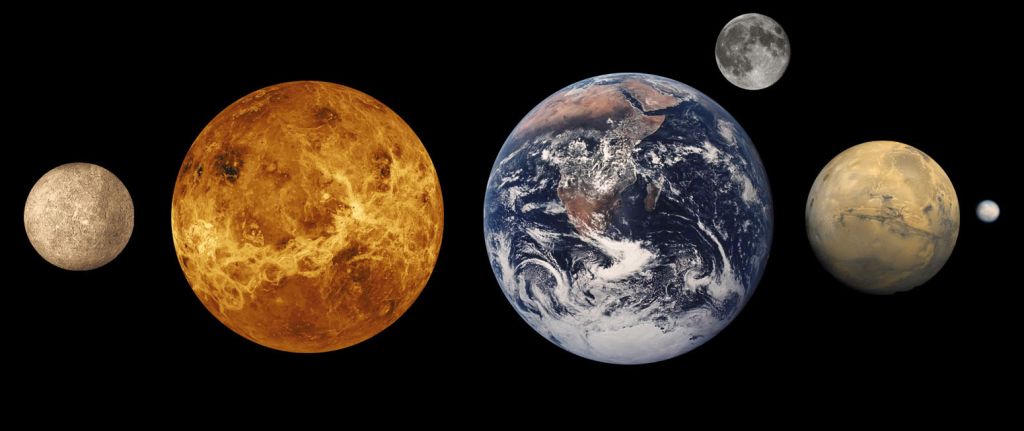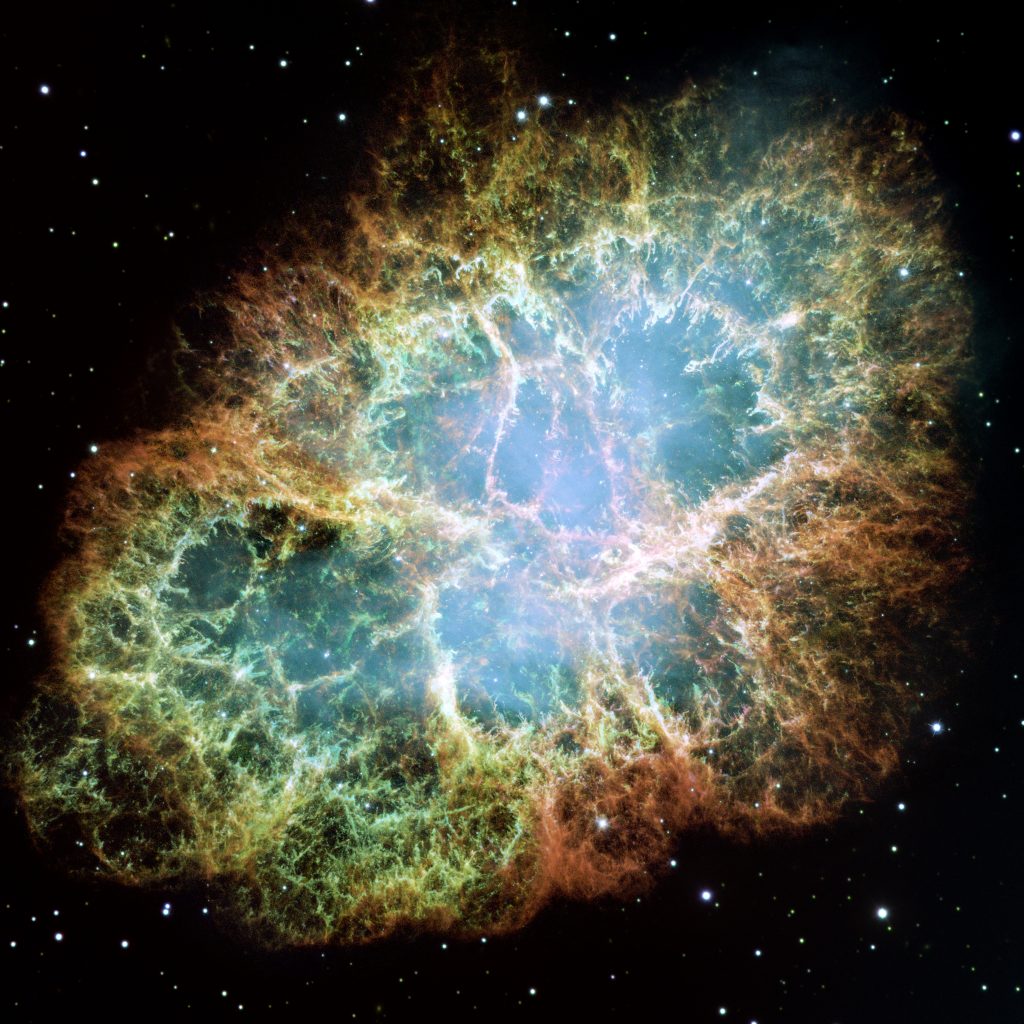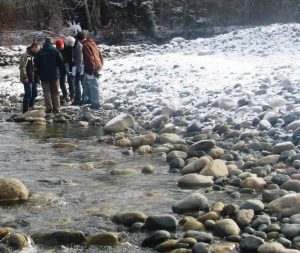1.1 Introduction

1.1.1 What is planetary geology?
You have probably heard of the fields geology and astronomy, but what about planetary science and planetary geology? Let’s consider what geology is first. In its broadest sense, geology is the study of Earth—its interior and its exterior surface, the minerals, rocks and other materials that are around us, the processes that have resulted in the formation of those materials, the water that flows on the surface and through the ground, the changes that have taken place over the vastness of geological time, and the changes we anticipate will take place in the near future. It is, arguably, one of the most integrated natural science disciplines because it requires a person to understand and apply all of the other sciences: physics, chemistry, biology, mathematics, and more. However, unlike most of the other sciences, geology has an extra dimension, that of time—deep time—billions of years of it. Geologists study the evidence that they see around them, but in most cases, they are observing the results of processes that happened thousands, millions, and even billions of years in the past. Those were processes that took place at incredibly slow rates—millimeters per year to centimeters per year—but because of the amount of time available, they produced massive results.

Similar to geology, planetary science is a multi-disciplinary field. However, it studies planets (including Earth!), their systems, and other celestial bodies in those systems such as moons asteroids and comets. There is some overlap between the fields of astronomy and planetary science, however, most planetary scientists focus on objects within our own solar system, although some are interested in exoplanets that reside other planetary systems. Unsurprisingly, planetary geology combines the fields of geology and planetary science. Planetary geology applies our knowledge of Earth’s geology to understand the properties, formation, and evolution of other planetary bodies in our solar system, with a special focus on solid objects (e.g., planets, moons, asteroids, comets, rings, meteorites, etc.).
This class introduces students to planetary geology and comparative planetology by taking them on a voyage through our cosmic neighborhood. Together, we will learn how scientists have come to better understand the origin and evolution of our solar system, other planetary systems, and even the origin and evolution of Earth, by examining the similarities and differences between planets, dwarf planets, moons, asteroids, and comets. Along this journey, we will visit rocky, icy, and gaseous worlds and encounter countless magnificent features and landscapes such as:
- a canyon system so large that, on Earth, it would stretch from Los Angeles to Washington, DC (Figure 1.2).
- the “heart” of Pluto—a million-square-mile bright region on the dwarf planet’s surface that is made of icy plains, mountains, and even glaciers.
- a crater and other evidence on Earth that tell us that the dinosaurs (and many other creatures) died because of a cosmic collision.
- a tiny moon whose gravity is so weak that one good throw from its surface could put a baseball into orbit.
- exploding stars whose violent end could wipe clean all of the life-forms on a planet orbiting a neighboring star (Figure 1.3).

Although we will discuss the latest planetary geology discoveries, we will pay equal attention to the process by which we have come to understand the realms beyond Earth, the tools we use to increase that understanding, and the impact of space exploration on humankind. By taking this class, I hope you will gain a greater appreciation for the wonders of the solar system, deeply understand the uniqueness of the planet we call home, and become a more informed citizen of the universe.
1.1.2 Science and the Scientific Method
Before we begin our journey through the solar system, let’s remind ourselves about the nature of science, because, as part of this class, you will be asked to think like a scientist. Have you ever asked yourself—or been asked by someone else—to define “science?” If yes, you may have found it difficult to define this word concisely, despite feeling like you know what it means. Science is a systematic discipline that uses objective and testable evidence to understand and explain processes and patterns of the natural world. In this way, science is more than just a body of knowledge; it provides a means to evaluate and create new knowledge without bias. Scientists follow a rigorous, repeatable approach to produce the objective evidence on which scientific knowledge is based; we call this approach the scientific method.
Numerous disciplines both within and beyond the natural sciences rely on the scientific method to perform research and learn about the world. At its core, the scientific method asks people to be skeptical, ask questions, and continuously be willing to revise findings based on new observations and evidence. The scientific method is not a formula but rather a series of steps that includes:
- Making observations and asking a question;
- Forming a hypothesis and making a prediction;
- Performing an experiment and gathering data;
- Analyzing data and drawing conclusions;
- (If necessary) Refining or forming a new hypothesis
- Communicating results through publication; and
- Devising an evidence-based theory

Figure 1.4: Diagram of the cyclical nature of the scientific method. [The Scientific Method as an Ongoing Process (2015), ArchonMagnus, CC BY-SA 4.0.]
Step One: Making Observations and Defining a Question
The scientific method begins with making many observations about an event, phenomenon, or process over a period of time. These observations can come from one’s experience in the real world or from reading existing literature on a subject. The latter approach to making observations is much more common in scientific research. Scientists synthesize observations and information about a topic by reading papers about previous scientific studies. During this information gathering process, a scientist might notice that a particular phenomenon is not well explained and develop a specific question related to how that phenomenon works. Wanting to learn more, the scientist asks a specific question about how the phenomenon.
Step Two: Forming a Hypothesis and Making a Prediction
Once the question is well defined, the scientist proposes a hypothesis. A hypothesis is a tentative but plausible answer to the research question that is based on the current state of scientific knowledge and/or the scientist’s own observations. A critical feature of a hypothesis is that it must be both testable and falsifiable; otherwise, you are not using the scientific method. Oftentimes, scientists develop multiple working hypotheses because they cannot impose strict controls on their experiments or have limited opportunities to visit a field location.
Using the hypothesis, the scientist makes a prediction—a specific statement that describes the result they would expect to see if their hypothesis is correct. Predictions typically are written in the form of an “if-then” statement. It is common for people to use the terms “hypothesis” and “prediction” interchangeably. While these two concepts are related, they are distinct from each other. To clarify this distinction, consider the below (made-up) example:
- Research Question: Why do roses have fewer aphids when they grow next to lavender?
- Hypothesis: Lavender repels aphids.
- Prediction: If lavender repels aphids, and we grow roses next to lavender, then we should find fewer aphids on the roses.
Step Three: Performing an Experiment and Gathering Data
The next step is to design and perform an experiment that tests the hypothesis/prediction. Many people mistakenly think experiments are only done in a lab; however, an experiment can consist of observing natural processes in the field or running a model. Regardless of what form an experiment takes, it always includes the systematic collection of objective data (i.e., evidence!). Scientists are careful to record the steps of their experiments, so others can reproduce them in the future and validate their results.
Step Four: Analyzing Data and Drawing Conclusions
Once the data is collected, it must be organized and interpreted. Scientists create graphs, tables, and other diagrams and perform statistical analyses to identify patterns between variables and draw conclusions. Ultimately, they will decide if their prediction came true and if the evidence clearly supports or contradicts their original hypothesis. It’s wonderful when the evidence supports the original hypothesis, but hypotheses are often wrong, and this is okay! This is still valuable information that can lead to great discovery and should be communicated with the scientific community.
In the scenario that evidence from an experiment refutes the hypothesis or doesn’t clearly support it, scientists will is go back to the drawing board and start the scientific method over again. They may conduct additional background research, revise their original hypothesis, and/or redesign their experimental procedure.
Step Five: Peer Review, Publication, and Replication
Scientists share the results of their research by publishing articles in scientific journals, such as Science and Nature. Reputable journals and publishing houses will not publish an experimental study until they have determined its methods are scientifically rigorous and the conclusions are supported by evidence. Before an article is published, it undergoes a rigorous peer review by scientific experts who scrutinize the methods, results, and discussion. Once an article is published, other scientists may attempt to replicate the results. This replication is necessary to confirm the reliability of the study’s reported results. A hypothesis that seemed compelling in one study might be proven false in studies conducted by other scientists. Additionally, new technology can be applied to published studies, which can aid in confirming or rejecting once-accepted ideas and/or hypotheses. In this way, science can be considered a social process. Scientists continuously communicate results and ideas to and seek guidance and feedback from their peers. The scientific review process aims to weed out misinformation, invalid research results, and wild speculation; as a result, the review process is slow, cautious, and conservative. The scientific community tends to wait until a hypothesis is supported by an overwhelming amount of evidence from many independent researchers before accepting it as scientific theory.

Step Six: Theory Development
You may have heard someone dismiss an idea by saying it is “just a theory,” but they are using the term incorrectly. In casual conversation, the word theory implies guesswork or speculation. In the language of science, a theory carries much more weight because it is an explanation or conclusion that is supported by experimental verification and widely accepted by the scientific community.
A theory starts out as a hypothesis. Only after a hypothesis has been repeatedly tested to eliminate false results, competing ideas, and possible variations does it become accepted as a reliable scientific theory. During this long period of testing, the now theory has never come up short. That doesn’t mean it never will, but the odds of that are very unlikely given our present (and conceivable future) state of knowledge.
While a hypothesis provides a tentative explanation before an experiment, a theory is the best explanation after being confirmed by multiple independent experiments. Confirmation of a theory may take years, or even longer. For example, the continental drift hypothesis first proposed by Alfred Wegener in 1912 was initially dismissed. After around seven decades of additional evidence collection by other scientists using more advanced technology, Wegener’s hypothesis was accepted and revised as the theory of plate tectonics.
The theory of evolution by natural selection is another example. Originating from the work of Charles Darwin in the mid-19th century, the theory of evolution has withstood generations of scientific testing for falsifiability. While it has been updated and revised to accommodate knowledge gained by using modern technologies, the theory of evolution continues to be supported by the latest evidence.
An Example of the Scientific Method at Work

Imagine we take a field trip to the stream shown in Figure 1.6. We notice that the rocks in and along the stream are rounded in shape rather than having sharp edges. These observations lead us to ask the question, “Why are the rocks in and along the stream rounded in shape?” We might hypothesize that the rocks are rounded because, as the stream carried them, they crashed into each other and pieces broke off. If this hypothesis is correct, we predict that rocks further downstream will be rounder and smaller and, if we move upstream, we will find larger and more angular rocks.To test our hypothesis, we plan to walk both downstream and upstream, observing and documenting the shape and size of rocks in each location. If we were patient, we could also test our hypothesis by performing an experiment. An experiment to test this hypothesis would be to place some angular cobbles in a stream, label them so that we can be sure to find them again later, and then return at various time intervals (over a period of years) to carefully measure their locations, roundness, and size.If our predictions turn out to be correct, we must still be careful about how much certainty to attach to our hypothesis. Although our hypothesis might seem to us to be the only reasonable explanation, someone could argue that we have the mechanism wrong, and the rocks weren’t rounded by bumping into each other. If our experiment didn’t specifically check for the mechanism (e.g., by looking to see if chips fall off the rocks and the rocks are made smoother) then we would have to acknowledge the possibility if a different mechanism being at play. We needn’t abandon our hypothesis as a useful tool for making predictions, but it is necessary to be open to the possibility that other things might be going on. If someone demonstrates conclusively that our hypothesis is wrong, then we have to discard the hypothesis and come up with a better one.
Remember, a good hypothesis is testable and falsifiable. Someone might argue that an extraterrestrial organization creates rounded rocks and places them in streams when nobody is looking. There is no practical way to test this hypothesis to confirm it, and there is no way to prove it false. Even if we never see aliens at work, we still can’t say they haven’t been, because according to the hypothesis they only work when people aren’t looking. Compare this to our original hypothesis which allows us to make testable predictions such as rocks getting smaller and rounder downstream. Our original hypothesis gives us a way to see how realistic it is, whereas the alien hypothesis gives us no way to know if it makes sense or not.
Sidenote: Laws vs. Theories
Another term that often appears in discussions of the scientific method is “law.” A scientific law is similar to a scientific theory in some ways but different in others. Let’s talk about the differences first.
While a theory is an explanation of a phenomenon, a law is a description of a phenomenon that is typically articulated using mathematical equations or concise language. A law describes the relationship between variables, and, in this way, it predicts the outcome of an event when specific conditions are met. Laws describe patterns in nature, but they do not explain why the patterns exist. Here’s an example: you could do thousands of tests where you drop an object with a known mass and measure its acceleration and the force with which it hits the ground. Again and again your results will yield the formula force = mass x acceleration. However, you don’t know what is responsible for the acceleration towards the ground. Yes, we say that gravity is pulling the object toward Earth’s surface, but why? Why does gravity exist? A law is true regardless of why a phenomenon happens as long as it describes the outcome of that phenomenon.
On the flipside, laws and theories are similar in that they both:
- Are fundamental principles that predict the behavior of the nature
- Have been heavily tested by the scientific method and are supported by extensive empirical evidence
- Are widely accepted and held to be universally true by most, if not all, scientists in a particular discipline
- Can be revised or replaced in the future if enough new evidence is found
It’s also important to emphasize that that a theory does not change into a scientific law with the accumulation of new or better evidence. They are two different concepts: theories are explanations and laws are descriptions or patterns. A theory will always stay a theory, and a law will always stay a law.
Over centuries scientists have extracted various scientific laws and theories from countless observations, hypotheses, and experiments. Because scientific laws are patterns, or, in a sense, the “rules” of the game that nature plays, they are particularly helpful for understanding the world around us, especially aspects of the world that are too small, too big, or too far away for us to readily see. The same laws apply everywhere in the universe. The rules that determine the motion of stars so far away that your eye cannot see them are the same laws that determine the arc of a baseball after a batter has hit it out of the park. Without the existence of such universal laws, we could not make much headway in science, especially fields like planetary science, planetary geology, and astronomy.
Text Attributions
The text of this chapter is adapted from:
- Sections 1 (Introduction), 1.2, 1.3, and 7 (Thinking Ahead) of OpenStax’s Astronomy 2e (2022) by Andrew Fraknoi, David Morrison, and Sidney Wolff. Licensed under CC BY 4.0. Access full book for free at this link.
- Chapter 1 of Physical Geology – 2nd Edition (2019) by Steven Earle. Licensed under CC BY 4.0, except where otherwise noted.
- Chapter 1 of An Introduction to Geology (2017) by Chris Johnson, Matthew D. Affolter, Paul Inkenbrandt, and Cam Mosher. Licensed under CC BY-NC-SA 4.0.
- Section 1.4 of Physical Geology, First University of Saskatchewan Edition (2019) by Karla Panchuk. Licensed under CC-BY-NC-SA 4.0.
The branch of science that studies Earth in the present and through time, including its composition, structure, the types of processes acting on it
The branch of science that studies everything in the universe beyond Earth’s atmosphere
A scientific discipline that seeks to understand planetary origins and evolution by examining the physical and chemical processes affecting planets over time, focusing on the similarities and differences between celestial bodies.
not influenced by personal feelings or opinions in considering and representing facts; unbiased
A possible answer to a research question that is based on some evidence, can be tested, and acts as a starting point for further investigation
A claim that can be evaluated as true or false using evidence collected through observation and/or experimentation
A claim that can be proven wrong using evidence collected through observation and/or experimentation
A physical, mathematical, or conceptual representation of a real phenomenon
Based on observation or experience rather than logic or belief
